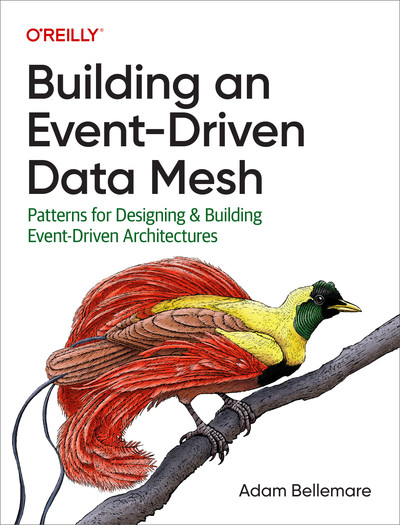Building an Event-Driven Data Mesh is one of these book titles that at first didn’t struck me, but once I started reading it, it suddenly brought my attention. It succeeds at bridging the gap between diffuse mesh ideals and the hands-on realities of streaming platforms. It’s highly recommended for those who seek a guide that balances architecture, governance, and implementation.
The book is more than two years old, but still valid today, it was published by O’Reilly in May 2023, the manual reflects a number of lessons author learned deploying Apache Kafka–centric platforms at Shopify, Confluent, and elsewhere, then layers them onto the four core data-mesh principles (domain ownership, data-as-a-product, federated governance, and a self-serve platform). The result is a book that is as opinionated as it is practical: it champions “shift-left” thinking, treats events as first-class citizens, and backs every pattern with hands-on advice.
 Source: O’Reilly
Source: O’Reilly
1. Book at a Glance
- Author & background – Bellemare is Staff Technologist in Confluent’s Office of the CTO and author of O’Reilly’s Building Event-Driven Microservices, giving him deep cred in both streaming and product thinking.
- Publication facts – 1st edition, 259 pp., ISBN 978-1098127602, released 9 May 2023.
- Stated goals – Help teams “power real-time operational and analytical workloads from a single set of data-product streams,” and avoid common migration pitfalls.
2. How the Material Is Structured
The table of contents opens with the fundamentals of event-driven communication, then walks through domain-oriented product design, governance, modeling event types (fact, delta, command), privacy/compliance, and scaling patterns before closing with migration strategies and case studies.
Each chapter ends with decision checklists—e.g., “Is this a fact or delta event?”—making it easy to translate theory into backlog items.
3. Key Ideas & Why They Matter
| Theme | What the Book Adds | Why It’s Useful |
|---|---|---|
| Shift-Left Data Processing | Moves cleansing/modeling work upstream so streams and tables come from the same high-fidelity source. | Reduces duplicated ETL and increases trust in data. |
| Federated Governance | Shows how global rules coexist with local autonomy, using RACI-style roles for data-product owners. | Aligns with mesh principle #3 and tames “wild-west” stream proliferation. |
| Events as Durable Products | Advocates treating each topic + schema + SLAs as a deployable artefact. | Enables discoverability, versioning, and contract testing. |
| Self-Serve Platform Patterns | Maps mesh needs onto Confluent/Kafka features (Schema Registry, Tableflow, Flink) but remains tech-agnostic. | Lets teams replicate ideas on AWS MSK, Pulsar, or Redpanda. |
| Real-Time + Batch Unity | Demonstrates how the same event stream can materialize Iceberg/Parquet tables for BI workloads. | Prevents “dual pipeline” anti-pattern and cuts infra spend. |
| Case-Driven Guidance | Summarizes Saxo Bank and logistics track-and-trace prototypes to ground patterns. | Offers real-world KPIs and pitfalls. |
4. Contents
The book’s greatest asset is its unapologetically hands-on stance. Bellemare rarely lingers on abstract principles; instead, he attaches each idea to concrete “day-1” and “year-1” checkpoints, migration milestones, and common anti-patterns to avoid. Just as important, he toggles smoothly between the social and the technical: organizational questions about ownership, contracts, and governance get the same attention as nuts-and-bolts topics like schema evolution and topic design. Because he weaves in debates on medallion-style lakehouses, kappa architectures, and the broader data-product toolchain, the guidance feels current rather than siloed.
That said, readers looking for a deep, code-level walkthrough may come away wanting more—the illustrative snippets are enough to spark ideas, but not enough to “wire up the mesh” end-to-end. The narrative also leans heavily on Kafka-centric tooling, which means teams running Pulsar, GCP Pub/Sub, or other stacks will need to translate examples. Finally, while privacy and compliance are addressed at a conceptual level, the book stops short of providing detailed security hardening patterns, leaving platform engineers to fill in that gap on their own.
5. Related books
| Book | Focus | Why Bellemare Still Adds Value |
|---|---|---|
| Implementing Data Mesh (Perrin, 2023) | Organization & contracts | Bellemare zooms in on streaming specifics missing elsewhere. |
| Streaming Data Mesh (Dulay, 2024) | Vendor-neutral EDA patterns | Bellemare offers a fuller governance narrative and migration playbook. |
| Data Mesh (Dehghani, 2022) | Foundational manifesto | Bellemare provides the “how-to-build-it-tomorrow” complement. |
6. Who Should Read It
- Data/platform architects needing an actionable path from monolithic lakes to decentralized streams.
- Engineering managers & product owners tasked with carving out data-product teams and governance.
- Senior data engineers already comfortable with Kafka or Kinesis who want to level-up on mesh thinking.
7. Takeaways
-
Start with a single high-value domain and publish a well-contracted stream/table data product—don’t boil the ocean.
-
Apply schema evolution rules aggressively; breaking changes break trust faster than pipelines.
-
Establish a lightweight federation council early to arbitrate global topics such as PII handling.
-
Instrument both stream and table modes; the unified lineage builds stakeholder confidence.